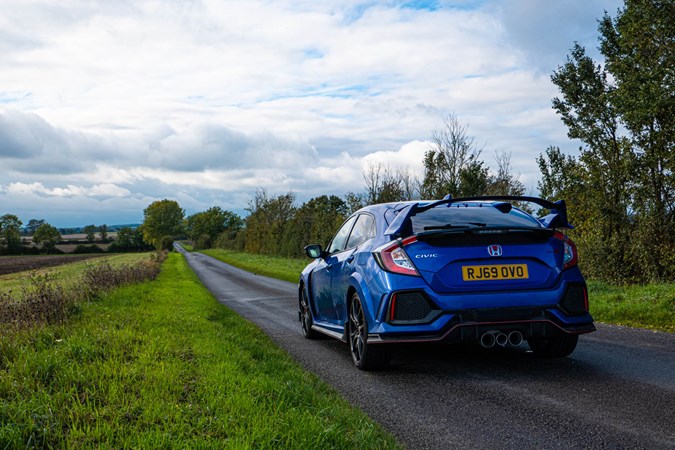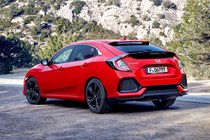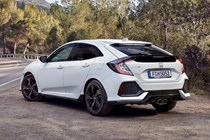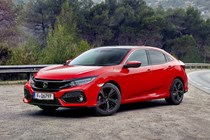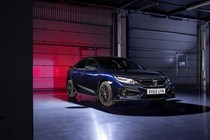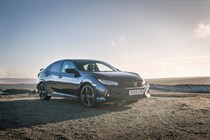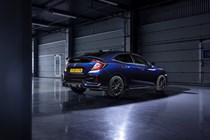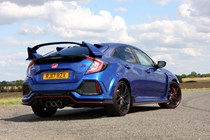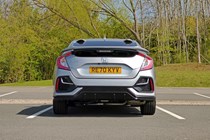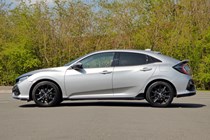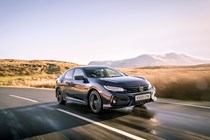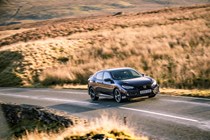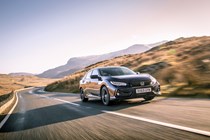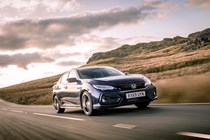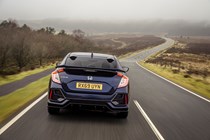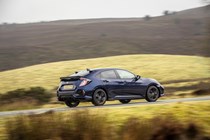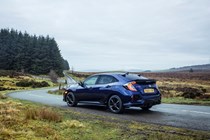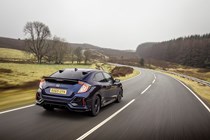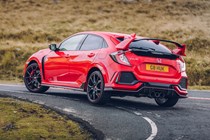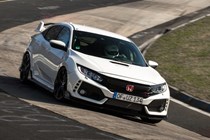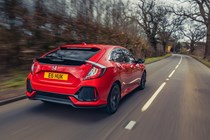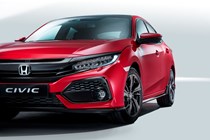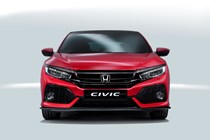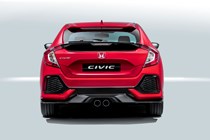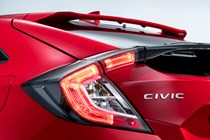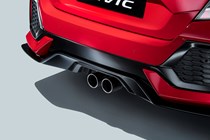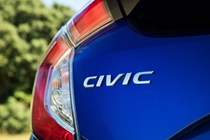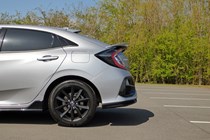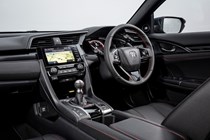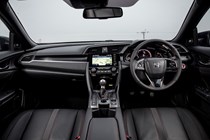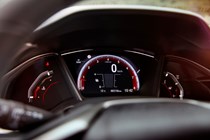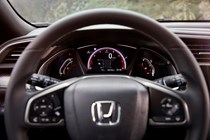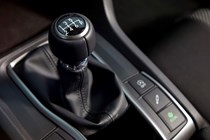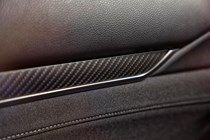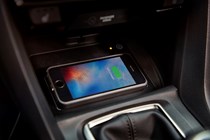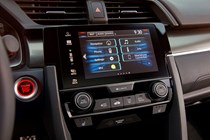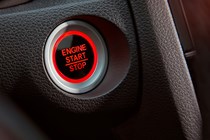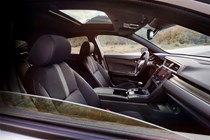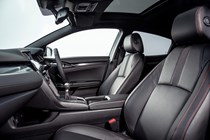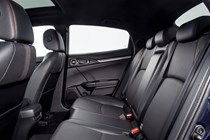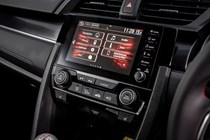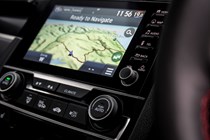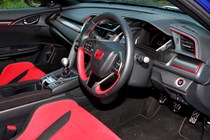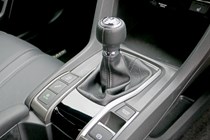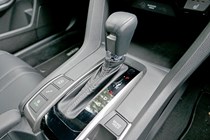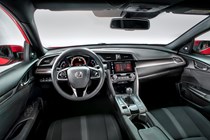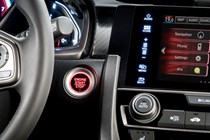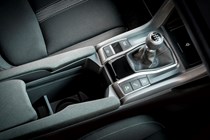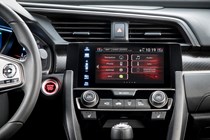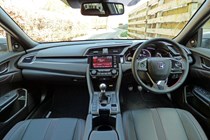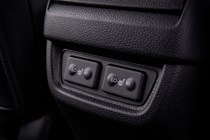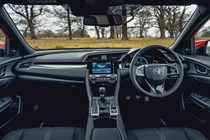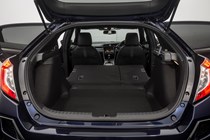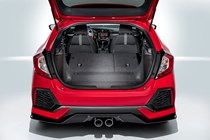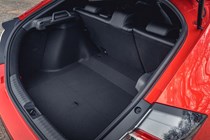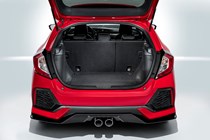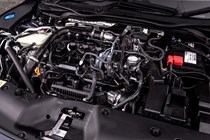
Honda Civic Hatchback (2017-2022) long-term test
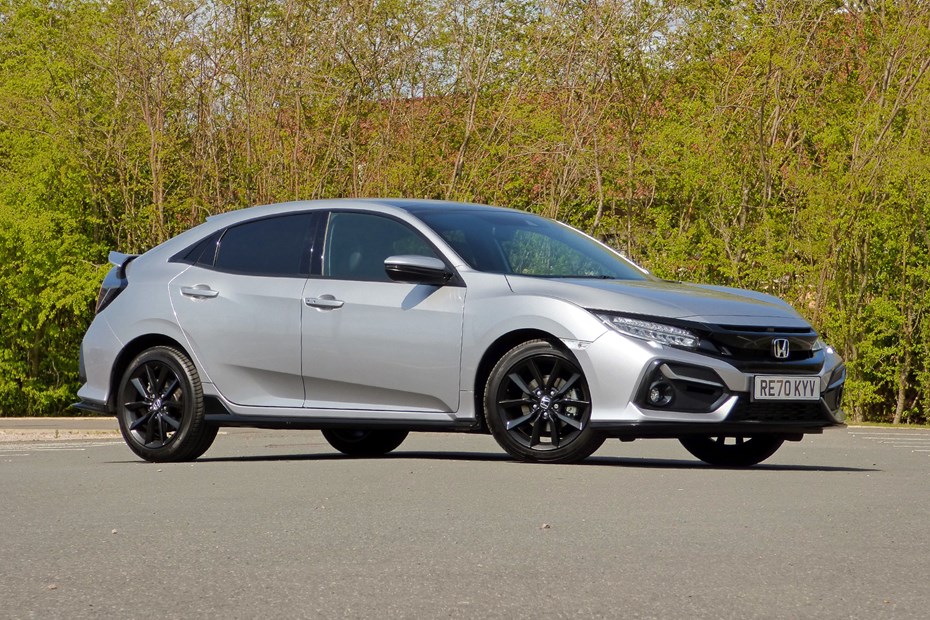
Update 1: Welcome
James Dennison tries to go all sensible with a brand-new Honda Civic long-termer – fails miserably…
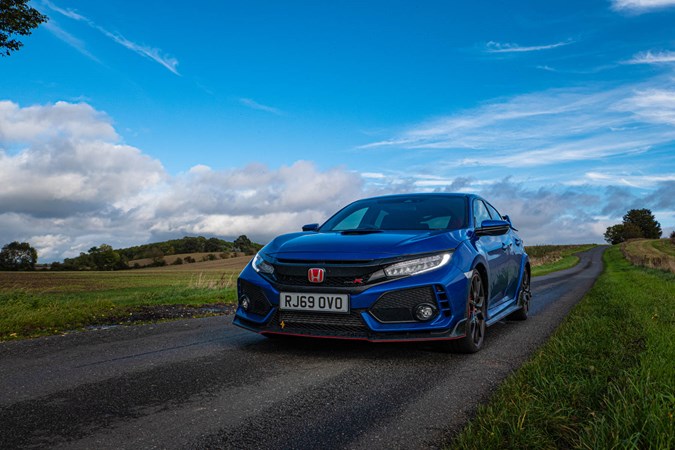
Having recently turned 26, I thought it’d be a good time to grow up and get a sensible, subtle long-termer for the next few months. Or maybe not, because following on from the conclusion of my Ford Fiesta ST long-term loan, I’m now going to be running another hot-hatch for the next few months. Welcome, everyone to ‘my’ Brilliant Sporty Blue Honda Civic Type R.
Why am I running this car? Well, for me – and indeed many others – it’s the finest hot-hatchback currently on sale, with almost all of this down to how it drives. And that’s great – for a blast down a quiet B-road. But hot hatches are the kind of cars that many owners will drive every day, meaning they can’t just nail the performance part of the brief.
Over the next few weeks and months, I’m going to live with RJ69 OVO and report on what it’s really like to live with Type R. How much it costs to buy, run, service, whether it’s reliable, how practical it is and how the much-maligned Honda infotainment system fairs for the average user.
It won’t all be straight-down-the-line ownerships impressions, however, because I’m keen to see whether the magic of the CTR’s wondrous drive wears off after a few months and how it fairs against other hot-hatchback rivals. I’ll also be pitting it against the facelifted Type R that’s landing in the summer, as well as the track-focused Limited Edition model. Will it really be better than the standard car?
Civic Type R GT spec or not?
All that to come, but first let’s have a look at the spec on ‘my’ Type R. I’ve already highlighted the Brilliant Sporty Blue paintwork and along with the regular or GT spec, it’s pretty much the only decision to make when buying a CTR. The logic with the blue – and don’t judge me here – was purely down to me wanting it to look like the now discontinued Subaru WRX STI. A car that many Type R owners will no doubt have approved of. All I need now is a set of gold wheels…
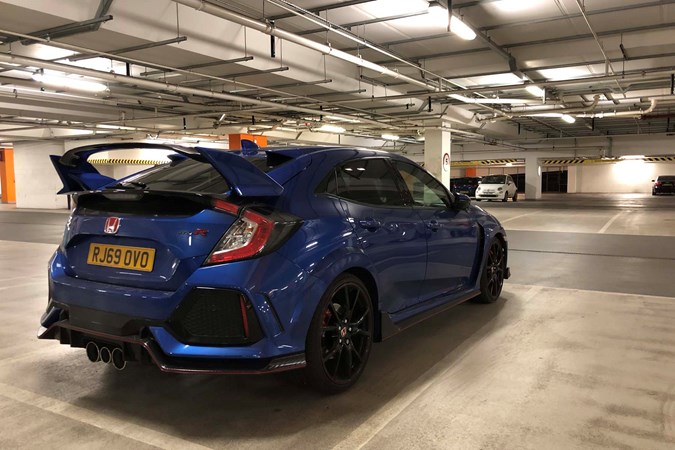
Onto the spec, and I’ve gone for the pricier GT version over the regular car. Why? Well, why not, really? It’s only fractionally more expensive in PCP finance payments than the non-GT (we’ll go into more detail on that in a later update) but you get lots of useful extra kit. So, along with the standard-fit rear-view camera, LED headlights, keyless entry and ignition and climate control, GT cars benefit from:
– Auto-dimming rear view mirror (mega-useful at night)
– Blindspot monitoring (like an extra pair of eyes on the road)
– Cross-traffic monitor (will probably seem unnecessary until the one time it saves you from trouble)
– Premium audio and Garmin sat-nav (keen to see how usable the stereo and sat-nav is)
– Dual-zone climate control (always handy)
– Front and rear parking sensors (yes please – the CTR isn’t a small car)
– Keyfob operated mirrors and windows (auto folding mirrors is a bonus)
– LED front fog lights (they look smarter, if that counts for anything)
– Red trim on bodywork – torn by this, does it work with the blue paint? (Senior Staff Writer Lawrence Cheung says ‘yes‘)
– Wireless charging (my passengers will be thrilled)
Running in the Type R
My first task is to finish off the running-in procedure that the good folks at Honda UK have already made a big dent in. I picked the car up on just under 450 miles and the user manual says to give it another 150 or so. That means keeping the revs varied (no regular cruise control on the motorway) and below 4,000rpm. After that, it’ll be normal driving for the CTR, so lots of runs on the A1 and a bit of town driving in the capital. Oh she’s in for a treat…
Mileage: 444 miles
Fuel economy (claimed): 36.7 mpg
Update 2: Performance and handling
James takes the Civic Type R on a post-lockdown road trip to Shropshire to test it’s hot-hatch capabilities
Here we go, straight into what is surely the most important part of living with a hot hatchback. How fast is it and how much of a smile does it put on your face? Well, in order to explain, allow me to go back in time a little to just after the UK came out of lockdown and my mates and I went for a little road trip…
After 12 weeks of not really driving the Civic Type R very much at all (apart from the odd enthusiastic trip down to Sainsburys), a road trip of some sort seemed appropriate – if not just to get the car out of 3rd gear for once. We (myself and a small group of mates) were supposed to be doing a longer driving holiday to Scotland, but that was canned (for obvious reasons), so a meander up to and around the stunning Shropshire hills was a good compromise.
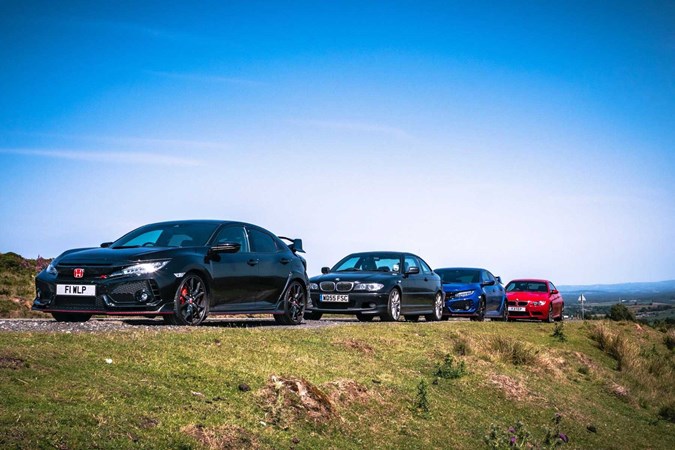
And, as you can see from the pics in this update, the FK8 Civic Type R was by far and away the most popular choice of car among our four-strong group of petrolheads. Not to mention the fact that the Brilliant Sporty Blue paintjob on OVO is really rather striking in the bright sunlight – more so than the Darth Vader get-up of my friend’s 17’ plate car.
The best handling front-wheel drive car on sale?
I think it might be. It took roughly five miles of spirited driving to remind myself what makes the Civic Type R such a fabulous tool for dissecting an unfamiliar road. It’s so pointy and precise at, yet there’s no fragility to the grip levels. Instead, it claws at the road with such tenacity that you’d swear the front tyres form a Velcro bond with the tarmac, only broken by the introduction of pesky precipitation.
There’s a tightness and cohesion, too, that’s difficult to achieve in a road car without making it ride like it’s shod with Bakelite casters. Every time you go over a bump, through a dip or over a crest, there’s a feeling that the car is prepared for it and ready with a solution to any of the driving inputs you then decide to make.
Even coming into a fast roundabout, it feels primed at a moment’s notice – yet never over-tensed. It’s been bandied around a lot since the car was launched, but in building the Civic from the ground up with the Type R firmly in mind, Honda has made the whole package work together brilliantly.
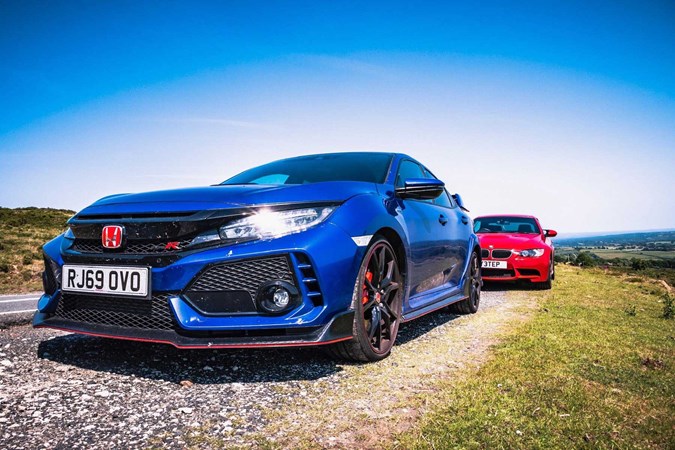
A slight criticism, though, and it’s one I hadn’t noticed on my previous – shorter – drives in the Type R. The steering – even in comfort mode – is quite heavy. Toggle Sport and R modes (the latter is mainly for track use) and it’s even heftier. Now of course, many drivers won’t see a problem with this, yet I’ve always felt that artificially heavy steering is there to cover up a lack of feel and tactility in a car – something which I don’t reckon the Civic Type R is guilty of. As such, it’s stopped me from using the Sport mode, purely because I prefer the lighter, less stodgy steering feel. And, interestingly, when I drove the British Touring Car equivalent of the Civic Type R on track last year, the steering was very light, as that’s how both professional drivers preferred it. I suspect many will disagree with me here, but there will also be plenty nodding in agreement.
2.0-litre turbocharged VTEC engine
It’s a curious one, the engine in the Civic Type R. It goes against the modern criteria for a hot-hatchbacks in that it’s not particularly loud and there’s no pops and bangs from the exhaust. Looking in from the outside, this might come across as a bit dull – a performance car with an engine that doesn’t know how to show off. And yet, in reality, it delivers something that’s really quite satisfying. Mainly because it feels like it knows its role and doesn’t try and go beyond it.
What I mean by that, is nearly every hot hatch currently on sale has a 2.0-litre-ish turbocharged petrol engine that develops upwards of 280hp. And, no matter how you swing it, there’s only so much a manufacturer can do with these engines in a road car. Put simply, they’re never going to be the centre of attention ahead of the chassis (or at least, they shouldn’t be).
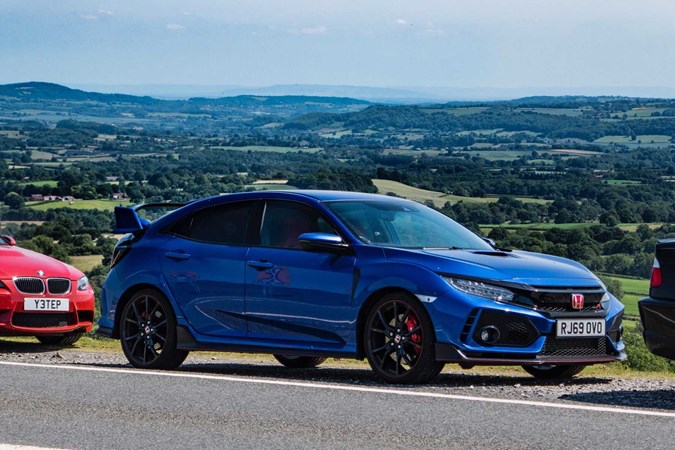
So what the 2.0-litre motor in the Civic Type R does is provide a torquey yet surprisingly revvy 320hp accompaniment to the brilliant chassis. And having lived with that engine note for a while now, I’m quite a fan of its unashamedly mechanical sound. No trickery, just the gentle whoosh of the turbo when you come off the throttle in a high gear. I have noticed it being a little lumpy when cold, yet it quickly gets into its stride and delivers devastating performance. For context, the red BMW M3 in the pics produces 420hp (100hp more than the Type R) yet, at roads speeds, it struggles to pull away in a straight line.
The six-speed manual gearbox is also worth a mention, largely because it’s perhaps the finest manual gearbox in any mainstream car on sale today. Each change is so deliberate and mechanical feeling, plus the ‘box has loosened up nicely during my time with OVO. The only downside is how cold (orhot) the brushed metal gear know can get in extreme temperatures. I have, however, solved this with a Type R branded gear knob wooly hat that I shall feature in a later update.
Mileage: 4001
Calculated fuel economy: 32.7 mpg
Update 3: Practicality
James has some rather unusual cargo for the Civic in this week’s update
The ‘stuff your hot-hatchback long-termer with a bookcase/weekly shop/sofa’ update in order to make a point about practicality has been done to death, so I’ve tried to be a different with my cargo. Wheels.
That’s right, four alloys (with tyres) for my MG ZR racing car. Of course, it came with wheels attached, but a spare (or 12) are always useful. Anyway, you might think loading four wheels into a car would be an easy task – just put two in the boot and two in the back seats, right?
Well, not quite, as – after going to pick up the wheels – I need to drive them 80 miles north to somewhere near Coventry. And didn’t fancy doing this with two unsecured lumps off metal rolling around the back seats. Because a) it’s not safe and b) the wheels themselves were – as you’d expect – filthy.
Cavernous boot space
So, here’s the challenge. Four full-size wheels in the boot of a 320hp hot hatchback without folding the seats down. Bring it on.
The first step was to remove the parcel shelf – except the Civic Type R doesn’t actually have a shelf. Instead, there’s a black piece of opaque fabric that pulls across the width of the boot.
Now of course you can’t actually put anything heavier than a rich tea biscuit on this, but – for me at least – it does exactly what it needs to, which is hide whatever is in the boot from prying eyes. Either way, it’s super easy to put in place or remove – so that’s a big tick in the usability box.
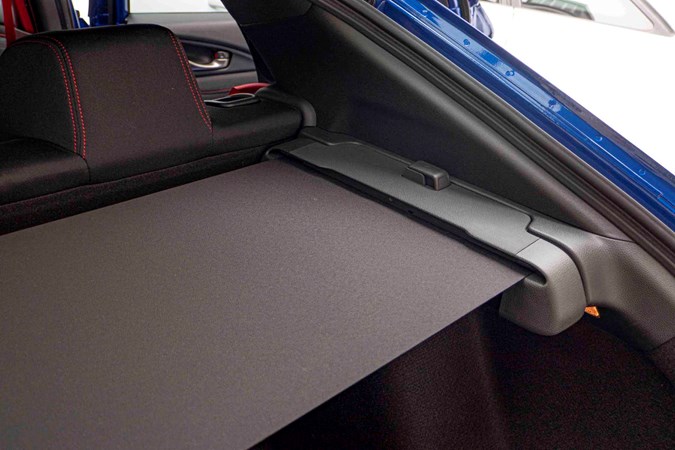
Lifting the wheels up and over the Civic Type R’s average-sized boot lip was an easy enough task (if not quite Honda Jazz levels of convenient) and everything was looking fine until I got to the last wheel.
Remember the parcel ‘shelf’ material? Well, the piece of plastic that contains the roller for said material is rather bulky and should the items you’re loading be tall enough to reach it (like the wheels), you lose a tiny bit of space widthways. Not a big deal, but just enough to mean my wheels wouldn’t fit side-by-side. Balls.
However, Honda hasn’t won years’ worth of acclaim in the practicality stakes for nothing as – to my delight – the parcel shelf roller instalment comes out entirely to allow for that extra bit of space. And so… Voila – all four wheels go into the Civic Type R’s boot so suspiciously well it’s almost like it was designed for it. Joy.
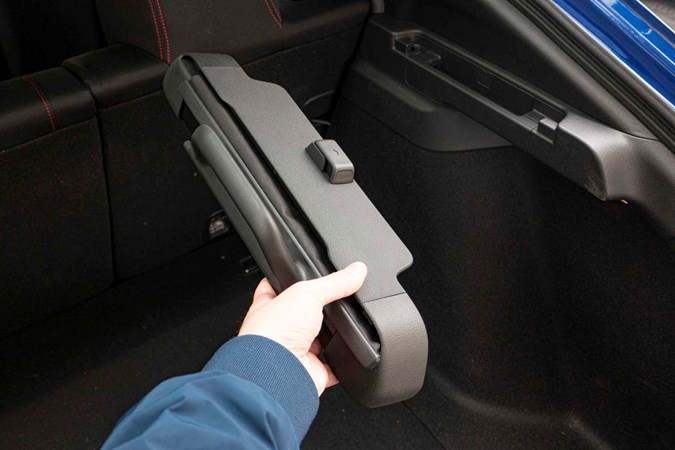
Maybe it shouldn’t be such a huge surprise, however, as the Civic Type R’s 420-litre boot (1,580 litres with the seats down) is larger than both the Renault Megane RS and VW Golf GTI. What’s more, the rear seats fold completely flat, making it easy to slide longer items in.
Large cabin, but only room for four
Since we’re on the subject of practicality, it would be remiss of me to not mention what it’s like for those sitting in the actual cabin. Up front, there’s all the leg and shoulder room you could need (a 6’ 8” friend of mine bought a Civic Type R and is still perfectly comfortable driving it three years later), plus storage space is generous.
There’s a large glovebox, plenty of space under the armrest, large door pockets, phone holder and even a hidden area below the centre console – just like you’d get in a regular Civic.
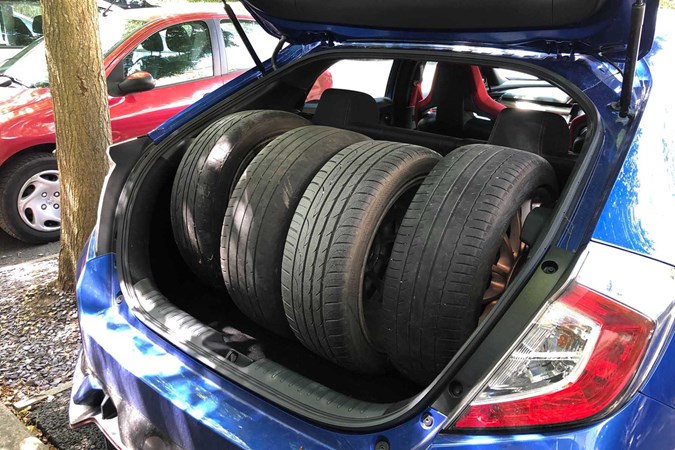
The only issue I can find is related to how many people I can fit in the back. There’s a respectable amount of headroom despite the sloping roofline (comfortable for a six-footer), yet for those odd occasions you need to squeeze as many people in your car as possible for short journeys, the Civic doesn’t have a middle seat. So you’re restricted to four passengers at any one time. Guaranteed, 90% of people reading this won’t care, yet for the other 10%, it’ll no doubt cause a headache.
Miles: 5975
Calculated fuel economy: 33.1 mpg
Update 4: Owning a Honda Civic Type R
James speaks to Will – an FK8 Civic Type R owner of three years – about the reality of buying a Honda hot-hatchback
Part of the appeal of running a long-term test car is that we get to see what said vehicle is really like to live with. There have been countless times when I’ve driven a car for a week and thought it either a) quite boring but probably very easy to live with or b) unique and exciting but no doubt an absolute pain to drive around everyday. Having the Civic Type R for an extended period of time, then, has helped me properly get my head around it.
BUT, it’s still not quite the same thing as owning one. Helpfully, however, I know a chap that does. Meet Will. We became friends at university and as far back as I can remember he’d always spoken about getting a Type R. Cue a spirited passenger ride (from yours truly) in the then new FK8 Civic Type R in late 2017 and that was that. He went out and bought a decidedly evil looking Crystal Black Pearl Model and hasn’t looked back since.
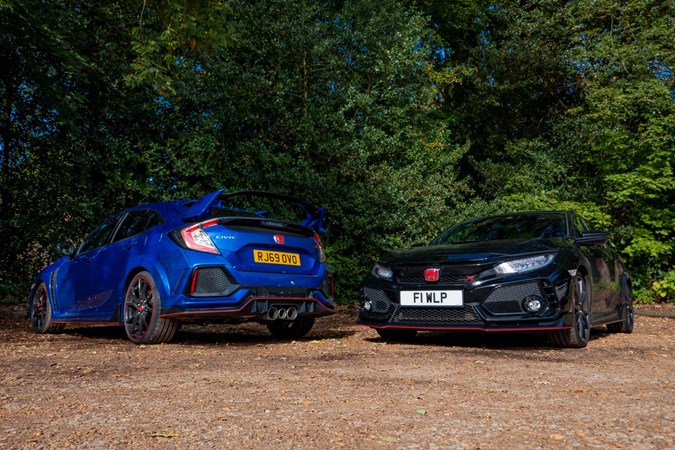
So, Will, why did you buy the Civic Type R?
Originally I’d wanted an FK2 (previous generation Civic Type R) but I then had the option to drive the FK8 and was sold immediately. It was that much more usable and up to date, plus the finance payments weren’t that much dearer.
And what’s been your favourite bit about the Type R?
So many things. I’m probably biased, but for me it’s still the best hot hatch on sale today. The steering and pedal feel is utterly superb and it just inspires so much confidence when you’re going quickly. And even when you’re not hacking along, it’s just a lovely thing to be behind the wheel of. You can drive along at 7/10ths and still enjoy yourself – it doesn’t demand to be thrashed.
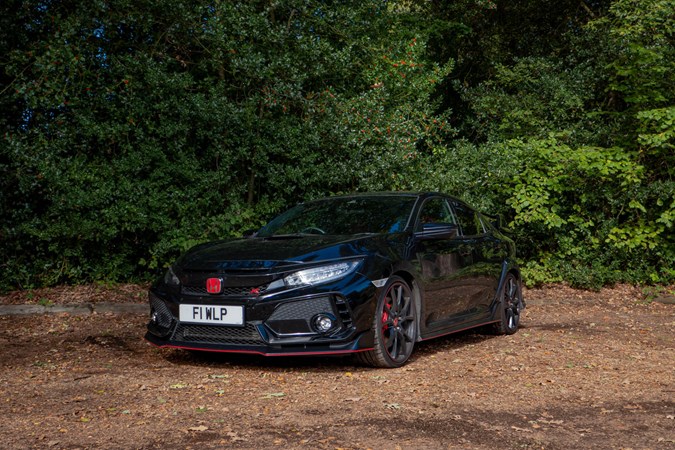
It’s also worth noting (as you can see from the pictures) that at 6’8” Will is rather tall. So how does the Civic Type R cope with his impressive height?
Very well, actually. There have been a few cars where I thought I’d be fine in but actually turned out to be incredibly uncomfortable, so the Civic was a pleasant surprise. I’ve driven it to Scotland and back a number of times and never had an issue. Aside from the exhaust which can drone a little at motorway speeds, all-round comfort is great. Much better than you’d expect from a hot-hatch that looks aggressive as this one does. And I’ve seen over 40mpg on a long run.
Any downsides?
A couple, but nothing major. The car has developed a few rattles in the time I’ve had it (so has the Parkers long-termer) and the lack of a spare wheel left me in a somewhat bothersome position on the way back from Scotland once. Oh yeah, and the fuel tank is too small at 46 litres, meaning I struggle to get 300 miles range.
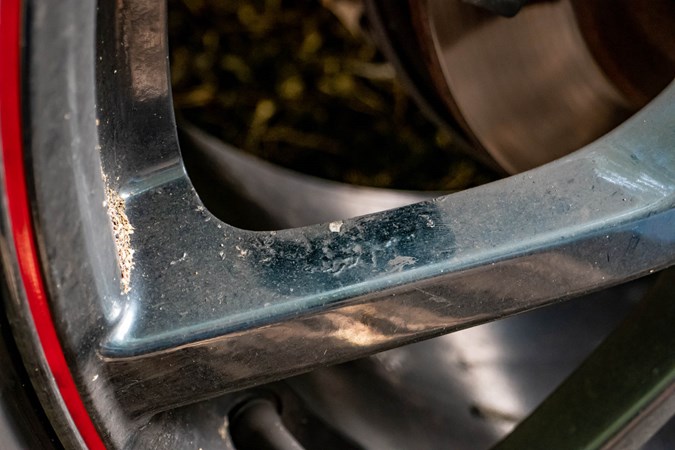
I’ve also noticed bubbling on each of the four wheels – something that I’ll definitely be sending the car back to the Honda dealer for. One thing I should also mention is the infotainment system. It gets a lot of bad press – and rightly so – but since I only use it with Apple CarPlay it’s hardly ever bothered me. So my advice is don’t let it put you off the car.
Would you recommend the Civic Type R?
Absolutely. I plan to keep mine for at least a couple more years and even then I’d struggle to know what to replace it with. It’s the kind of car that, even as it gets older, will still be right up there for the way it drives. I don’t want to sound like a Honda fanboy but it’s just generally a fantastic car.
So, Will still loves his Civic Type R after almost three years of ownership – a ringing endorsement if ever there was one. If you’ve got an FK8 Honda Civic Type R and want to share your experiences, get in touch via Twitter @JDennisonCars or email – james.dennison@parkers.co.uk. Alternatively, why not write an owners review for our website!
UPDATE: Will took his Civic Type R to his local dealer and pointed out the bubbling on the alloy wheels. Immediately recognising the problem, they agreed to replace all four wheels free of charge. Top marks to Yeomans Honda.

Miles: 6421
Calculated fuel economy: 33.8 mpg
Photos by Jade Porter
Update 5: New vs slightly less new?
James grills his chum and colleague, Adam Binnie, on whether the facelifted FK8 Type R is worth it
The more observant among you will have noticed that, as I reach the penultimate report in my time with the Honda, it is a car that is no longer on sale. Don’t panic, though, as you can still buy a brand-new Civic Type R, but in 2020 facelift form. And, although there’s not that much change in the looks department with the newer model, Honda has done some under the skin fettling.
There’s a revised grille, new two-piece brake discs, retuned suspension, a fancy new tear drop shaped gear knob and, wait for it, a volume knob! Hurrah – no more stabbing away at those ineffectual touch ‘buttons’ trying to shut off a particularly irksome DJ at 6:30 in the morning. We should also point out that there’s a couple of extra Type R versions, too, such as the subtler (although not by much) Sport Line and track-focused Limited Edition – which has already sold out.
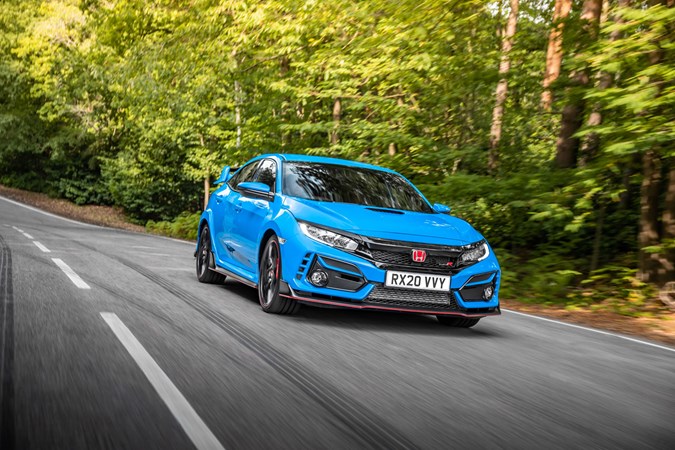
Today, however, I’m interested in the bread and butter Type R. The OG, as it were. And whether it’s worth getting this facelift version over a pre-facelift car, such as RJ69 OVO. After all, the tweaks look pretty subtle on paper and there’s a few thousand-pound saving to be had if you play your cards right.
Complicating matters, however, is the fact that I’ve not driven the newer model. Poor, I know, but not working at an office anymore means it’s harder to jump in and out of cars like I used to. However, I do know a man that has had extensive time in both the facelift and pre facelift cars, so please allow my colleague Adam Binnie to give you the verdict.
When we have a Type R on a group test I usually leave it until the end of the day to drive because it’s been out for ages now and I know what it’s all about. Then, when I think I’ve got an order of best to worst in my head, I jump in the Civic for the sake of completeness and realise it’s still my favourite hot hatch by a very inaccurately measured mile. This has now happened to me three times.
So I was a bit confused to find out Honda had spent time and money improving areas of the FK8 that frankly, I didn’t realise needed improving. Such as fitting a heavier gearknob.

One or two of the tweaks for the 2020 car will only be obvious to drivers with a track day addiction so let’s get those out of the way – the 13% larger opening in the front bumper and reduced radiator pitch contributing to under-bonnet temperatures running a promised 10 degrees lower, for example.
Slightly more relevant is the new two-piece floating disc rotor design, which bends less when you stand on the brakes, and claims to take 15mm of slack out of the pedal. Hold out your right foot (or left if you’re so inclined) and push it forward by exactly 15mm. You cannot. This is an almost imperceptibly small measurement, but one that clearly kept Honda’s engineers up at night.
The sampling rate on the adaptive dampers has been improved, too (although it’s still slower than the Golf GTI’s), so the Civic can read the road better and therefore deliver a calmer ride or flatter handling, depending on mode. In truth, neither of these were areas that the old car felt lacking.
Step inside for more tangible improvements – a gripper, Alcantara-clad wheel, Active Sound Control that cancels out noise in Comfort mode and enhances it in +R, and that reshaped knob I mentioned earlier. The Civic Type R has one of, if not the most precise manual gearshifts on sale, but this upgrade makes it comfier in your hand (stop it) and more accurate too.
Marginal gains, then, that result in an even better driving experience overall. If you’re shopping for hot hatches then do as I do and leave the Civic test drive until last, because I guarantee it’ll be the one you go home in.
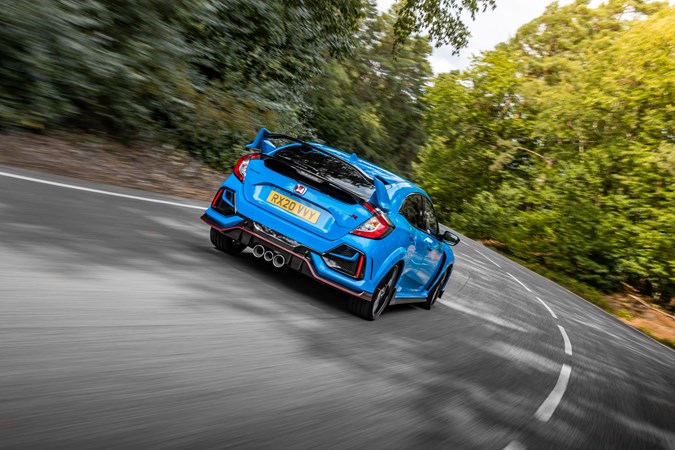
But is the updated Civic Type R worth it?
Everything being even, yes, it is. It makes the best a tiny bit better – and how doesn’t want that? But if there’s a noticeable premium to pay, then no. Get the old one and save the money for trackdays.
So there you go. Do it if you can and it nakes financial sense. But if not, then rest assured you’re still getting one of the finest hot hatches on sale today and, more importantly, won’t be left behind by those who’ve opted for the newer model.
Miles: 7701
Calculated fuel economy: 34.2mpg
Update 6 – Goodbye Civic Type R
James delivers his final verdict after living with the Honda Civic Type R for six months
So here we are, my time with the FK8 Honda Civic Type R has come to an end. In what has certainly been the strangest long-term loan of any press car I’ve ever run, the CTR spent a good chunk of time sitting idle outside my flat, it’s engine only firing into life for a government-approved essential shopping trip. And yes, it did, on occasion, splutter rather than spring into life owing to its long periods of enforced rest.
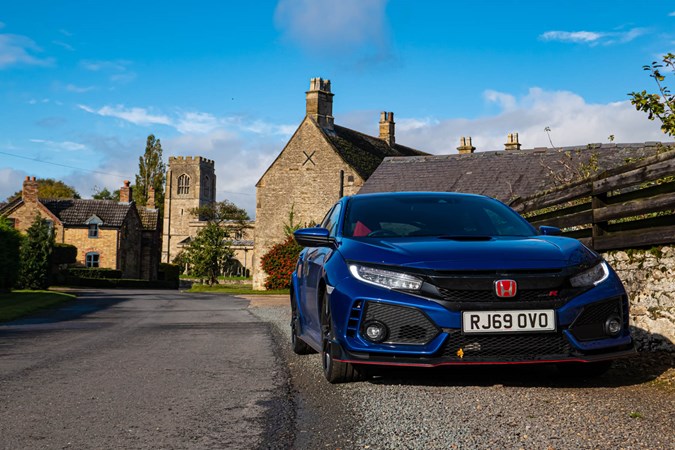
At times, I did think it a waste to have a 320hp hot-hatch sitting outside doing nothing. Surely a super-comfortable SUV, city run-around or even an electric car would have done the job better. But no, the CTR was pretty much perfect for me. Because during the UK’s three-month lockdown it punctuated the otherwise dull and monotonous essential trips with an occasional sprinkle of magic, reminding me why it’s one of the finest hot hatches ever built.
Whether it was a quickly taken roundabout, or mercifully clear stretch of dual-carriageway to ring the engine out, each journey always had the potential for joy, even if just for a few seconds. And when you’re stuck in doors for a few months, such things do make a difference. I can’t believe I was the only person looking forward to their essential drives out!
Best bits of the Civic Type R
Performance. It should go without saying, but just in case you’re in any doubt I’ll fill you in. This is a ballistically quick car, both in a straight line and through the corners. It doesn’t have a week point when it comes to going fast, although you do need to have a light touch on the throttle when the road is wet.
I fail to see how taking the wonderful manual gearbox (possible the finest on any mainstream car today) up through each of its six-forward speeds, ringing out every last horsepower as this sensible hatch turned touring car rips towards the horizon, could ever get boring. It’s such a sweet engine and chassis combination and one that you’d have to look to far pricier machines to do better.
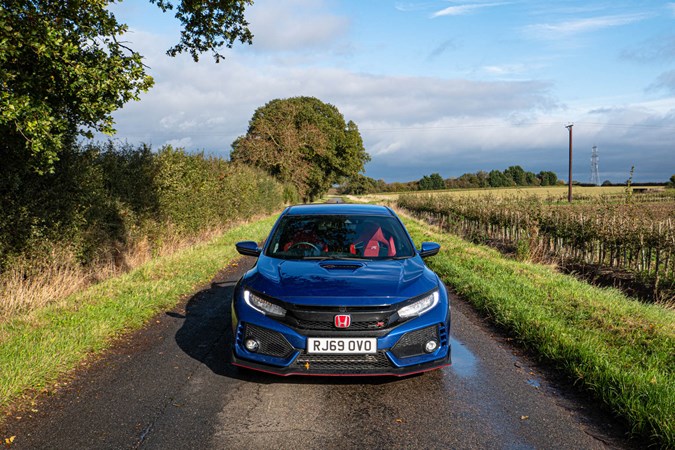
Usability. At the beginning of these reports, I questioned how easy it would be to live with such an aggressive looking hot-hatchback. And the answer is, well, very easy. There’s not been one occasion when I’ve had to adjust my plans because I’m driving a performance car. It’s swallowed four full-size wheels in the boot, devoured 400-mile trips with ease and even provided an impromptu changing room on race days. A fifth seat was never needed, but I’ve no doubt some would find it handy.
Comfort. I’m not always a fan of adaptive dampers. Sometimes, they can leave you feeling like you’ve got a compromised version of the car in each of the different modes and that a one-size fits all fixed setup would be preferable. But not so in the CTR. Race mode is dead firm and perfect for track use, yet the regular comfort setting is also deeply impressive. How a sizeable hatchback can corner so flatly yet also deliver a pliant ride is purely down to the magic of the adaptive dampers.
Worst bits of the Civic Type R
The fuel tank. I’ve touched on this in an earlier update, but a 46-litre capacity really isn’t enough, despite the impressive 34.4mpg average I achieved over 8,000 miles. Fellow CTR owner Will Porter, see report 4, also had the same frustrations – reporting that his wife’s first-generation MINI Hatch has a larger 50-litre tank!
The infotainment system. Oh dear, this really isn’t the car’s finest point. Slow, poorly designed menus make it a faff to even switch radio stations, plus the lack of a volume knob (now rectified in post-facelift cars) was a frustrating design omission. Still, Apple CarPlay does make things a lot easier. And yet, even then there’s an issue where the car would play whatever song I last had on every time I started the car – regardless of what I do with my phone. A pain – and one that I never managed to get to the bottom of.
Not much else. I did, at times, feel that the steering was too heavy in all modes and that the driving position could be lower. Plus, an annoying rattle did develop from the steering column a few weeks before I handed the car back. But this aside, the complaints column is notably sparse.
The Verdict
It’s certainly not the newest hot-hatch anymore and it’s never going to be the shrinking violet of the car world, yet the Honda Civic Type R is still a hugely desirable purchase. We knew it’s brilliant for a blast down a country road, yet running it over the last six months has proven that it’s also more than capable of being an effective daily companion – even during the most extraordinary of times.
Next up for me is a BMW 4 Series Coupe, so keep an eye out on the Parkers website and Parkers Cars YouTube channel for more my introductory update!.
Miles: 8,496
Calculated fuel economy: 34.5mpg
